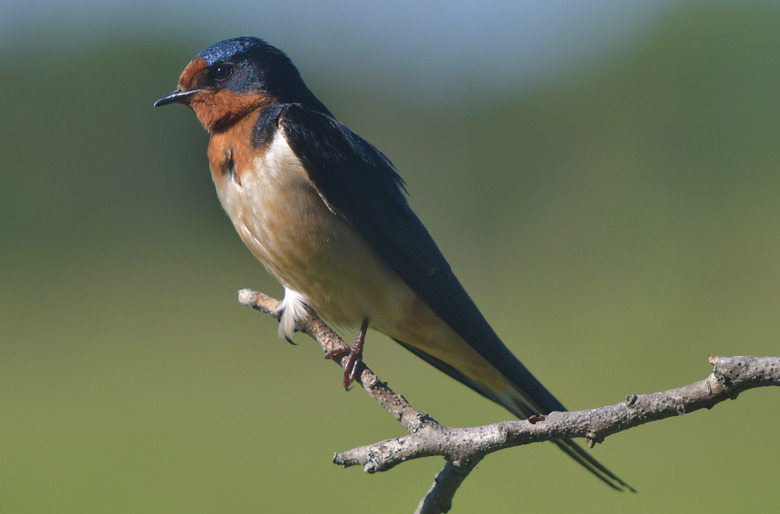How To Build A Barn Swallow's Nest
Barn swallows, with their forked tails, distinct red and blue feather patterns, and unique nesting habits, are one of the most common and most recognizable swallow species. Though these small birds are adored by birdwatchers and gardeners across North America, where they make pest control a spectacle, the barn swallow population has had its habitat damaged in recent years – to the point that it is considered a species in decline in certain regions of the United States and Canada. Suburban development and construction in rural areas have destroyed a crucial part of the birds' nesting habitats. The barns and similar structures that the swallows get their common name from, often old or in states of neglect, are being demolished. Luckily, it is easy to support your local barn swallow population by building a nesting place for them.
TL;DR (Too Long; Didn't Read)
The barn swallow builds its nest around human structures, in places like barn rafters and under the eaves of houses. As a result, building an entire barn swallow birdhouse is excessive; providing a simple barn swallow nest box on a vertical wall in the right environment, with a source of mud and a source of food nearby, is all that is necessary to support the birds in your area.
Swallows Nesting Habits
Swallows
Nesting Habits
The barn swallow is native to North America and can be found across the continental United States and the warmer regions of Canada. The birds nest between the months of May and August, near open areas with water sources, where they can maneuver and catch insects to eat. What distinguishes the barn swallow from many of its relatives, however, is its preference to build nests on and inside human buildings. When possible, barn swallows build their nests in places like chimneys, barn rafters, and under bridges or the eaves of houses. Barn swallow nests are made of mud, grass and feathers, forming a sort of open cup shape. They will return to their nests annually to lay eggs and raise young.
Habitat Planning
Habitat
Planning
Building a nesting place for barn swallows in your area is a simple process, but it's not the same as building a traditional birdhouse; because barn swallows dislike enclosed spaces, a nest cup or open nest box is far more effective. These can be built from wood, glue and/or wire, depending on the design of the nesting place. Detailed plans for nest cups and nest boxes are easily found online, but regardless of nesting place, barn swallows will need a source of food, a source of water and a source of mud before they will take up residence. A bird feeder and birdbath can be placed nearby, and a hose can be used to create a mud source.
Habitat Building
Habitat
Building
Building and placing nest cups and nest boxes is easy, though there are some things to keep in mind when placing them: Nest cups can be built by cutting a moderately sized wooden bowl (between 6 and 8 inches in diameter) in half, and then gluing the semi-circle to a wooden board. Nest cups can be placed under eaves and other overhangs, but if one isn't present a nest box with one (acting as a roof) will do just as well.
Nest boxes, built from thin wooden boards, need a floor at least 8 inches long and 7 inches wide; they should be at least 12 inches tall and should have a roof at least an inch longer than the floor. It should have side walls, but these should cover no more than half the length of the nest box floor – and the box should have one completely open side. Nesting places should be placed between 7 and 12 feet from the ground and should be at least 5 feet from each other. Don't put the nesting place near a door or place of heavy human traffic, as the birds will defend their nests. Note that if you're going to put the nest box or cup indoors, in a shed, barn or similar place, you must ensure that the birds have 24-hour access to the location.
Cite This Article
MLA
Flournoy, Blake. "How To Build A Barn Swallow's Nest" sciencing.com, https://www.sciencing.com/build-barn-swallows-nest-7778381/. 22 November 2019.
APA
Flournoy, Blake. (2019, November 22). How To Build A Barn Swallow's Nest. sciencing.com. Retrieved from https://www.sciencing.com/build-barn-swallows-nest-7778381/
Chicago
Flournoy, Blake. How To Build A Barn Swallow's Nest last modified March 24, 2022. https://www.sciencing.com/build-barn-swallows-nest-7778381/
